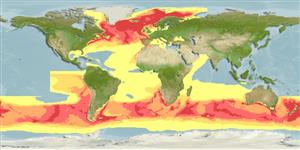Common names from other countries
Environment: milieu / climate zone / depth range / distribution range
Écologie
Pélagique; profondeur 30 - 1800 m (Ref. 122880). Polar; 90°N - 90°S, 180°W - 180°E
Northeast Atlantic, Atlantic Ocean, Indo-Pacific, Mediterranean, and the Antarctic: Central Pacific sector at 68°S, 120°W; Globicephala melas melas: Ungava Bay, Greenland, Iceland, Faroes, Norway, North Carolina, Azores, Madeira, Mauritania, Western Mediterranean, Newfoundland; Globicephala melas subsp.: Japan, Sea of Japan; Globicephala melas edwardii: Brazil, South Africa, Crozet, Heard Island, Australia, New Zealand, Chile, Scott Island, Antarctic Convergence (Ref. 1522). Polar, subtropical.
Length at first maturity / Taille / Poids / Âge
Maturity: Lm ? range ? - ? cm Max length : 670 cm TL mâle / non sexé; (Ref. 1394); 570 cm TL (female); poids max. publié: 2.0 t (Ref. 1394)
Found in oceanic waters and some coastal waters of the North Atlantic Ocean. Feeds on squid and sometimes small medium-sized fish (Ref. 1394). Found in oceanic waters and some coastal waters of the North Atlantic Ocean. Feeds on squid and sometimes small medium-sized fish (Ref. 1394).
Jefferson, T.A., S. Leatherwood and M.A. Webber. 1993. (Ref. 1394)
Statut dans la liste rouge de l'IUCN (Ref. 130435)
statut CITES (Ref. 108899)
Utilisations par l'homme
Pêcheries: commercial
FAO - pêcheries: landings, species profile | FishSource | Sea Around Us
Outils
Sources Internet
Estimates based on models
Preferred temperature
(Ref.
115969): 1.6 - 10, mean 3.7 (based on 3239 cells).
Résilience
Faible, temps minimum de doublement de population : 4,5 à 14 années (K=0.1; tm=12).
Vulnérabilité
Very high vulnerability (90 of 100).
Catégorie de prix
Unknown.
